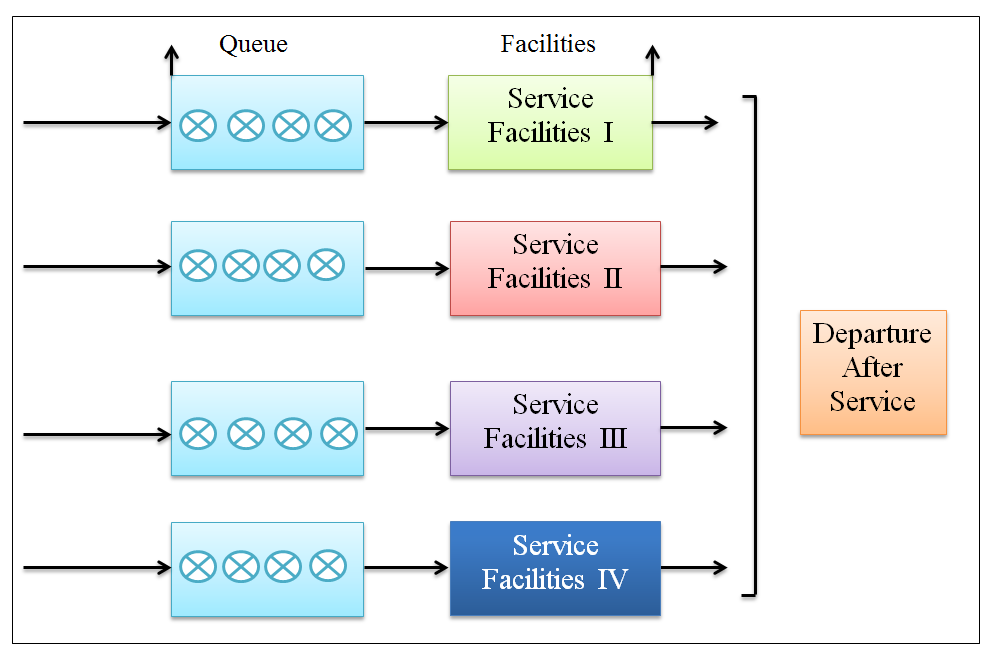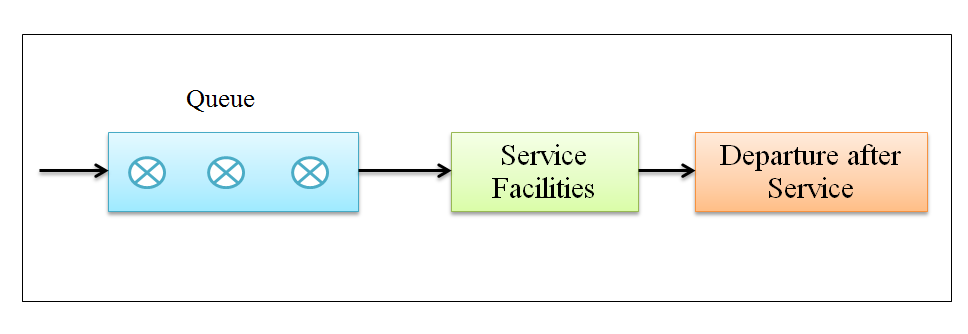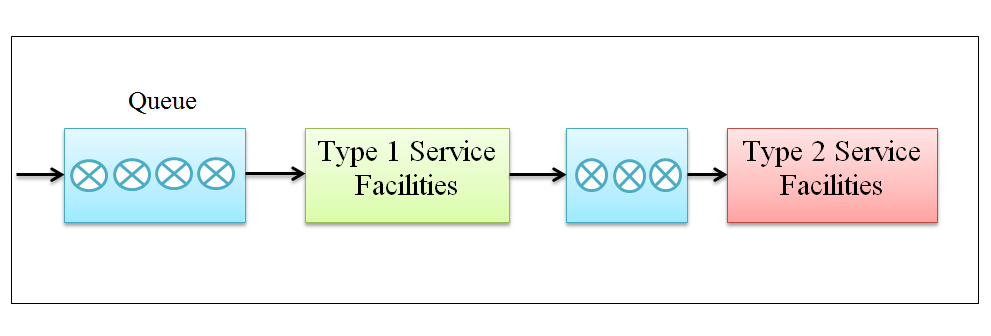Service System/Queuing Process/Queuing System
The basic Queuing process can be described as a process in which the customers arrive for service at a service counter (or station), wait for their turn in the queue if the server is busy in the service of the other customer and are served when the server gets free. Finally the customer leave the system as soon as he is served.
The Queuing system has following main elements:
1. The input (Arrival Pattern)
2. Queue (Waiting line)
3. The service discipline (Queue discipline)
4. The service mechanism (Service pattern)
1. The input (Arrival Pattern)
The input describes the pattern in which the customers arrive for service. Since the units for service (customers) arrive in a random fashion therefore, their arrival pattern can be described in terms of probabilities.
2. Queue
This specifically refers to the number of customers waiting in line. Someone being served is not usually included in the queue. In some operations customers form a physical queue (people waiting in a line in a supermarket), but sometimes the queue is hidden or ‘virtual’ (telephone callers to speak to a call centre operative).
3. Queue discipline
The order is which the customers are selected from the queue for service is known as queue discipline. This can be one of the following type:
i. First In First Served (FCFS) or First In First Out (FIFO)
FIFS arrangement selection of customers for service is done in the order in which they arrives and forms the queue.
ii. Last In, First Served (LIFS) or First In , First Out (FIFO)
Under LIFS arrangement selection of customers for service is done in the reverse order in which they arrive and the person entering last is the first to be selected for service. It is not an appropriate method. Such practice is common in the case of issue of stores, as the storekeepers finds it more convenient to remove the items in LIFS order while issuing for job.
iii. Service in Random Order (SIRO)
In case of service in random order customers are selected at random out of those present at the service state at that particular time.
iv. Service in Priority (SIP)
Under such an arrangement certain customers are given priority over other in selection for service. The priority can be of two types viz. Non-pre-emptive, where the customer already getting served is allowed to continue with service till it is completed even a priority customer arrives mid-way during the service, and pre-emptive priority customer arrives. This is in the case of when some critical machine breaks down in a factory. Repair of these critical machines is given top priority even by stopping the repair of less important machines.
v. Shortest Processed First (SPF)
This is a queuing system that selects for execution the waiting process with the smallest execution time.For example a customer with 6 items only will be attended first. This can work well but only if customers/users understands it and respect the concept.
4. Service pattern
The service mechanism refers to :
a) The pattern according to which the customers are served.
b) Facilities given to the customers
The facilities can be classified as:
i. Single channel
Here the customers are served by one counter only i.e. only one customer can be served at a time, e.g. at cinema ticket window or a library counter.
ii. Service Facility in a Series
In this when a customer enters he gets one kind of service and then moves to the next station, gets some service and then again moves on to the next and so on and ultimately leaves the system. For example, machining of a certain steel item may consist of cutting, turning, knurling, drilling, grinding and packing operations each of which is performed by a single server in a series.
iii. Multiple, parallel facilities with single queue
In this model, there is more than one server. Each server provides the same facilities e.g. washing of a car on a shop having more than one washer.
iv. Multiple parallel facilities with multiple queues
Reservation of Railway Tickets at the Railways Stations is an example of this type of model.

Customer Behaviour in a Queue
Various customers while in queue behave differently. Their behavior pattern can fall in one of the following categories.
1. Balking
A customer may not like to wait in a que due to lack of space or otherwise. They do not join the queue at their correct position and attempt to jump the queue and reach the service centre by passing other ahead of them. This is known as balking.
2. Reneging
A customer may leave the queue due to impatience. This is called reneging.
3. Collusion
Some customers may collaborate and only one of them may join the queue. As at the cinema ticket window one person may join the queue and purchase tickets for his friends.
4. Jockeying
If there are more than one queues then one customer may leave one queue and join the other. This occurs generally in the super market or shopping malls.




